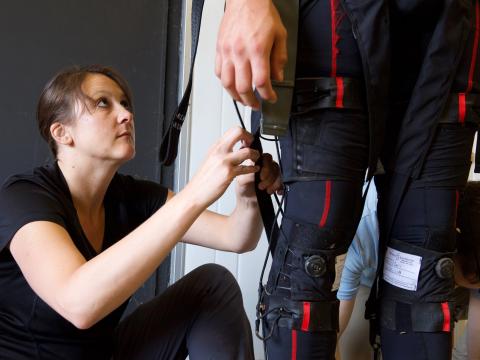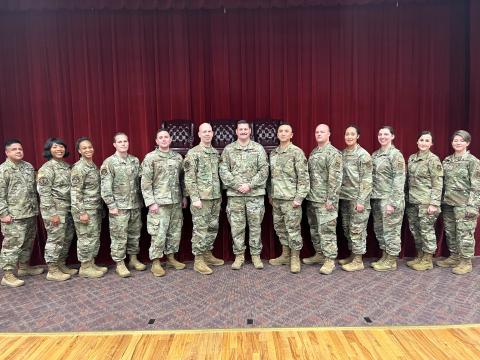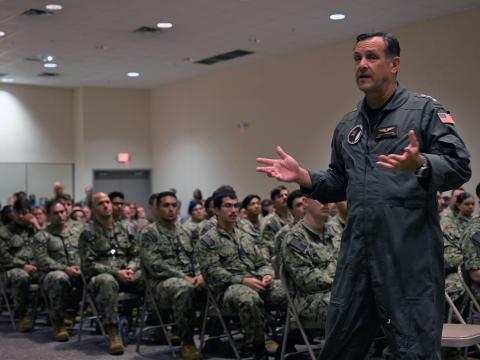Defense Department Researchers Aim for Sky-Based Switchboard
The future of tactical military communications with full interoperability may be up in the air.
The Defense Department is striving to link its diverse battlefield communications through a single system based on an airborne platform. This system would be capable of providing connectivity among radio and cellular telephony users while loitering over a theater of operations, and its capabilities could also be applied to intelligence collection and dissemination.
The airborne unit, which could be based on manned or unmanned aircraft, is designed to address potential communications shortcomings that can arise during an overseas operation in an unfamiliar area. Despite interoperability strides, many joint or coalition forces have dissimilar communications systems. Forces that arrive first in theater can have limited, if any, reachback capabilities. A significant number of communications, intelligence, surveillance and reconnaissance systems are designed for line-of-sight operations, which is a drawback when over-the-horizon conditions emerge. Above all, increased reliance on information sharing, especially through proposed tactical internets, strains bandwidth capacity.
All these problems could be overcome with the development of the airborne communications system. The only obstacle is its enabling technology. Current capabilities are some distance away from achieving the system’s proposed interoperability and multiple frequency functionality goals.
Work on solving these challenges, which began at the Defense Advanced Research Projects Agency (DARPA), is now moving into private industry. Three industry teams have been selected to work on the airborne switchboard, which DARPA has designated the airborne communications node. Most of DARPA’s thrust has involved technology investigation and feasibility studies. Last year, the effort transitioned to building a prototype airborne communications node.
“It essentially is a wireless communications switch in the sky,” DARPA’s Gladys Reichlen, program manager in the agency’s sensor technology office explains. The system is designed to provide voice, data and image services employing approximately 75 channels and 17 waveforms. She relates that the basis for the airborne communications node is a software-programmable radio channel. Programming in desired waveforms for each of the different systems will permit users to communicate across them. The program’s goal is to achieve range extension and interoperability among disparate radio systems.
The single channel ground and airborne radio system (SINCGARS) and the ultra high frequency line-of-sight/ Have Quick system would enjoy range extension for 10 to 20 channels. Similar benefits could be applied to the enhanced position location reporting system, or EPLRS (one to three channels), Link 16 (one channel) and the tactical wideband relay for mobile subscriber equipment (two to four channels).
It might serve as a surrogate tactical satellite employing 10 to 20 channels. It could provide high-speed infrastructure access ranging from 10 to 45 megabits per second, and tactical battlefield multicast capabilities would run from 64 to 1,544 kilobits per second. Up to 600 users could have access to Internet-type data networking with nonblocking service. Cellular or personal communications system telephony would be capable of handling up to 200 calls.
“You could think of it as a relay; you could think of it as a gateway,” Reichlen says. “There is no reason the service that would be provided [to the user] would have to be an extension of one individual system.”
The airborne communications node is designed to address a key tactical communications challenge: sustain communications without any existing infrastructure. Most of the commercial low-earth-orbit satellite systems and high-altitude, long-endurance systems offered for this capability cannot meet this requirement. Some proposed systems could provide cellular or Internet-type high-capacity access, but they all presume the existence of a base station located on the ground in or near the theater of operations. Providing base-station service without a ground facility requires hosting the capability on an airborne platform—in this case, the airborne communications node.
“Providing an airborne communications node that is too limited in functionality will get us into trouble, from a defense perspective,” Reichlen states.
The program manager admits, however, that attaining these goals is not guaranteed. “I have had some technical experts tell me that we will be lucky if we can achieve these,” she says. “Even if we can’t get this full capability, it will be such a greater capability than what already exists that it will be a phenomenal enhancement to the military’s operational capabilities.
“I personally believe that these are achievable goals,” she declares.
To generate the necessary advances for successful system development, DARPA issued a set of services and constraints such as size, weight, power and cost. With these services and constraints established, design challenges were left up to the contractors. The three teams are headed by Raytheon, Sanders and TRW. Reichlen declares that her goal is to achieve full flyaway payload capability for less than $5 million per unit. She emphasizes, however, that this price is a guideline, not a hard and fast ceiling.
One unique facet would be a design capable of scaling modularity, programmability, size, weight and power. This would enable the use of different platforms based on mission needs and capabilities. For example, a full-platform capability might be configured to the size, weight and power limitations of a Global Hawk unmanned aerial vehicle. Some subsets of this capability also might be installed on a mission-specific platform such as a smaller unmanned aerial vehicle, a helicopter or an aircraft.
“The intent is for all of these [configurations] to be airborne platforms supporting on-the-move communications,” Reichlen says. A single mission could employ multiple platforms with different capabilities over a broad area.
Reichlen notes that these aerial systems are being tailored to accommodate the latest commercial communications technologies. As an example, these platforms could serve as switches linking ground users with the ORBCOMM satellite messaging system. “Communications from an airborne communications node go horizontally and vertically, both down and up,” Reichlen explains. “Just as it could use a geostationary satellite to reach back to the continental United States, there is no reason an airborne communications node could not talk to an Iridium or another [commercial satellite system],” she emphasizes.
Most of the services’ vision statements anticipate having some type of airborne communications node, Reichlen points out. The task of developing such a system fell to DARPA because of the technological challenges, she states. Currently, all the radio frequency systems that are intended to be present on this platform seemingly conflict in frequency spectrum. Existing technology does not overcome the problem. For example, four SINCGARS frequencies can operate concurrently, but adding a fifth frequency jams operations. To build the airborne communications node, designers are tasked with enabling 20 of these transmits simultaneously, Reichlen says. All told, the platform must deal with electromagnetic compatibility among more than 75 collocated transceivers.
This problem is likely to grow as new radio systems begin military operations, but necessary technologies must be developed independently. The joint tactical radio system, or JTRS, is planned to serve as the services’ standard software-programmable radio system. Where the current Speakeasy radio features four channels and four waveforms, JTRS is planned to have four channels and 10 waveforms by 2001. Over the same timeframe, the airborne communications node must be developed to handle 75 channels and 17 waveforms. Reichlen allows that technology developed for the airborne system could apply to JTRS.
Another technical challenge involves establishing an internet overlay on multiple levels of mobility. This problem plagued designers of the tactical internet when they were dealing with only one level of mobility, Reichlen relates. The airborne system would need to ensure interoperation among itself, mobile assets and the fixed infrastructure. A key industry task is to develop and implement protocols that accommodate multiple levels of mobility with survivability and autonomy.
Above all, these capabilities must be incorporated into a package that is light enough and small enough to fit aboard a Global Hawk unmanned aerial vehicle. Currently, enabling just four SINCGARS channels to operate simultaneously mandates interference mitigation and radio frequency systems that would require a large 70-pound box. The entire 75-channel, 17-waveform capability must be designed to fit into 100 cubic feet and weigh no more than 450 pounds. The complete system must consume only 5 kilowatts of power. This is the most difficult structural challenge, Reichlen states. These design parameters are more stringent than those needed to operate aboard a Global Hawk, she shares.
Looking ahead, she foresees the potential for an additional intelligence capability being added to this system. Its receivers, after all, are types of sensors. An airborne platform with a situational awareness capability offers many potential applications in battlefield intelligence, and planners might seek to add new digital processing capabilities in the near future. So, this system is being designed to leave room for additional elements that would take advantage of its assets.
Several technologies are key to the development of an operational system. Mitigating cosite radio frequency interference among the 75 emitters will require active cancellation and frequency-hopping multiplexing or filtering. Low-power, linear and low-temperature silicon carbide power amplifiers are also needed.
Reichlen reveals that some interesting antenna designs are being proposed. Primary needs include conformal and meanderline broadband antennas. For the 17 waveforms, software-reprogrammable radios must enable analog voice and 45 megabits per second of data with low probability of intercept/low probability of detection.
Control, switching and networking present a complex engineering problem encompassing message formatting, a host of encryption algorithms and keys, and a mobile internetworking overlay for the system’s 75 channels and 17 waveforms. And, meeting the system’s size and weight constraints will require advanced field-programmable gate arrays, micro-electromechanical devices and analog/digital converters.
Each team is taking a different approach to designing the system, Reichlen says. As a result, each team may view different areas as presenting the greatest challenges, depending on their levels of expertise.
The three Phase I teams will be working on aircraft integration for flight demonstration of a prototype system on a manned platform. This phase is scheduled to conclude at the end of this year with a functional demonstration on a C-135 aircraft and the submission of Phase II proposals.
Reichlen explains that the documentation provided in Phase I will constitute each team’s technical proposal for Phase II. At this point, a single contractor will be selected to build the system; Phase II integration will run through 2000 midway into 2001. An unmanned aerial vehicle flight demonstration currently is slated for September 2001. The program would develop two payloads for Global Hawk unmanned aerial vehicles, one helicopter payload and one payload control terminal.



